


Field pea, Pisum sativum L, having a productivity of 942 kg/ha is a major crop of rabi season in Assam. It is cultivated in an area of about 30,000 hectares. Field pea is primarily used for consumption or as livestock feed by cracking or grounding. It contains about 5-20% lesser trypsin inhibitor than soybeans. Therefore, it is widely used as fodder crops without undergoing extrusion heating process to inhibit the enzyme. Research has shown that field pea is an excellent protein supplement in swine, cow, feeder calf, dairy and poultry rations.
Field peas are also grown as a green manure or as green fallow crop. This not only increases the cropping intensity of the field but also improve the soil fertility. Peas are leguminous plants and has the capacity to fix atmospheric nitrogen from its root nodules. It is estimated that, about 50-60 kg/ha of residual nitrogen is fixed in the soil by leguminous plants in one cropping season. Therefore, growing pea for crop rotation not only increases the cropping intensity but also improves the soil fertility.
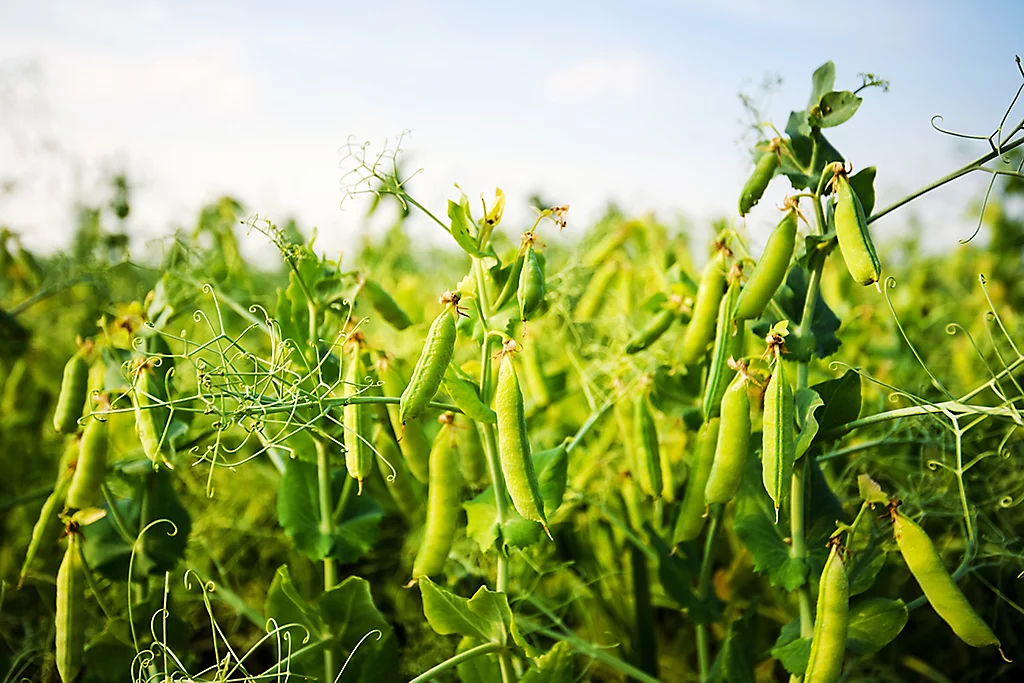

Dried peas are commercially valued due to its high nutritional content, especially protein. 100 g of dried peas consist of about 19.2-27.3 g of protein, 42.4 g of carbohydrates, 2.3 g of fats, 4.5-7.9 g of fibers, 712 mg of Sodium, 50-100 mg of Calcium and 200-1100 mg of Potassium. Also, the presence of abundant lysin and tryptophan which is mostly devoid in cereal grains adds to its value.

| Crop | Area (‘000 ha) | Production (in ton) | Productivity (kg/ha) |
|---|---|---|---|
| Blackgram | 58.956 | 39545 | 671 |
| Arhar | 6.052 | 5244 | 866 |
| Greengram | 13.553 | 10344 | 763 |
| Lentil | 27.312 | 22564 | 826 |
| Peas | 28.441 | 26800 | 942 |
| Gram (chickpea) | 2.568 | 1964 | 763 |
| Other pulses | 16.426 | 14126 | 860 |
| Total pulses | 153.308 | 120587 | 787 |

Pea requires moderate temperature throughout the growing season. High temperature causes more harm to the crop than frost. It is only during the flowering stage that frost causes harm to the crop. High humidity and cloudy weather results in spreading of fungal diseases such as powdery mildew. The optimum temperature for growing pea is 13-18°C.

Peas can be grown on a variety of soils, however, well drained light soil like loamy soil are most suitable.

| Varieties | Duration (days) | Yield (q/ha) | Other characters |
|---|---|---|---|
| Rachna | 120-125 | 10-12 | Tolerant to powdery mildew. A tall variety (135-138 cm) |
| FP (Plant-14) | 108 | 11.49 | Recommended for Hill Zone only. Moderately Resistant to rust |
| AAU SPC 101(Xeuti) | 105-107 | 14-15 | Resistant to powdery mildew, tolerant to rust. Moderately resistant to pod borer, aphids & leaf miner |

Pea generally requires reasonably deeply worked soils. The field is to be ploughed 3 to 4 times to obtain a good tilth.
Optimum time of sowing is mid of October to mid Nov.
The field is to be ploughed 3-4 times to obtain a good tilth.
60 kg/ha or 8 kg/bigha. In riverine tracts of Assam, the recommended seed rate is 4-6 kg/bigha
The seeds are to be sown in lines at a spacing of 30 cm between rows and 10 cm between plants.
Seed treatment with Carbendazim or Benomyl @ 2 g/kg of seed or Captan or Thiram @3 g/kg of seed is recommended.
Rhizobium culture @ 50 g/kg seed is to be used for seed inoculation
: Most plants are grown in slightly acidic soil however; peas required a slightly neutral soil. Therefore, liming with calcium and magnesium is done to bring the soil to the pH of around 6.0, at least 21 days before sowing. CaCO3 in the form of dolomitic lime @ 65.5 kg/bigha should be applied 15-21 days before seeding and incorporated in the soil in areas where multiple cropping is practiced.
Pea seeds at 25-50% higher rate are to be broadcast in the standing crop of rice about 15-20 days before harvest provided the soil is in moist condition. In rice + pea relay cropping, seeding of pea at 20 days after 50% flowering of rice with a seeding rate of 90 kg/ha is recommended in medium Sali land for Hills Zone. Pea seeds are to be soaked overnight before sowing
Compost of FYM @ 4-5 t/ha or 6 q/bigha should be applied
| Nutrient | Requirement (kg/ha) | Form | Fertilizer Requirement (kg/ha) | Fertilizer Requirement (kg/bigha) |
|---|---|---|---|---|
| A. Without Rhizobium culture | ||||
| N | 20 | Urea | 45 | 16 |
| P2O5 | 46 | SSP | 287 | 38 |
| K2O | 15 | MOP | 25 | 3.3 |
| B. With Rhizobium culture | ||||
| N | 10 | Urea | 22 | 3 |
| P2O5 | 36 | SSP | 227 | 38 |
| K2O | 15 | MOP | 25 | 3.3 |
In North Bank Plain Zone, 10 kg Borax/ha is also recommended. Diammonium phosphate (DAP) @ 100 kg/ha or 13 kg/bigha should be applied in lieu of urea and SSP in non-inoculated crop. NPK may also be supplied in the form of; mixed fertilizers. Apply all the fertilizers as based followed by foliar spray of 0.5 % NPK (19:19:19)at pre -flowering & pod initial stage.
Apply Fluchloralin 45 % EC @ 1.5 kg a.i./ha as pre-emergence herbicide one day before sowing and to be incorporated in the soil with light hoeing.
If required and available, one irrigation should be given at 40-50 days after sowing.

How to identify:
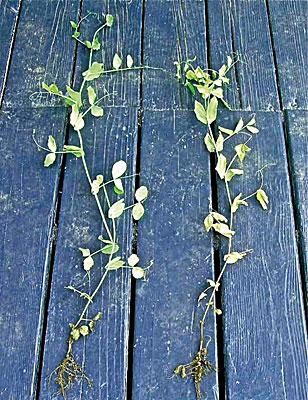
Leaves of infected plants develop small,orange-brown pustules
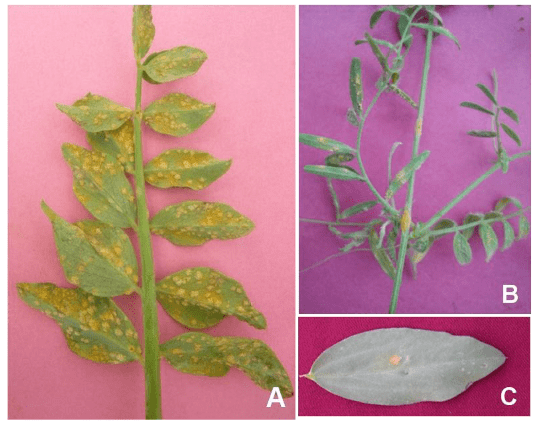
Rotting of collar region with presence of white mycelial growth. At later stage mustard seeds like sclerotia produces at the infected plant parts.
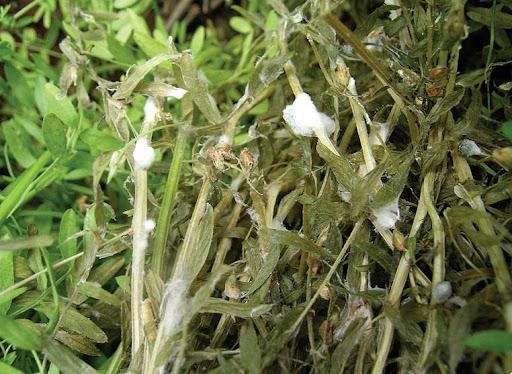
Infected plants are to be collected along with sclerotia and burnt.
Warm temperature (15-25°C), humid (over 70% relative humidity) conditions for 4-5 days in the late vegetative stage, during flowering and pod filling, favor disease development
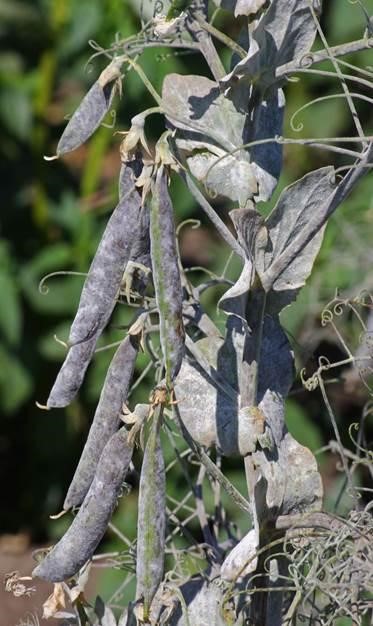
Young caterpillars feed on the tender foliage and cause defoliation in early stages. Larvae bore into the pods and destroy the seeds by making a round hole. While feeding, the larvae put their head inside the pod leaving the rest of its body inside.
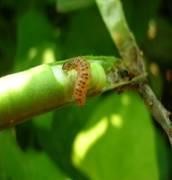

Harvesting should be done when 75-80% pods turn yellow.
For long term storage, the peas are sun dried for 3-4 days till the moisture content of the peas are reduced to 9-10%. For large scale storage, fumigate the store room/house before and after monsoon with ALP @ 1-2 tablets per tones to prevent the development of bruchids and other storage pest. For a small-scale storage, field peas can be protected from the pest by mixing with inert material such as soft stone, lime, ashes, etc., or by smearing with edible/non-edible vegetable oils. Mixing peas with powdered neem leaf @ 1-2% w/w is also practiced widely.
Jorhat, PIN - 785013 Assam